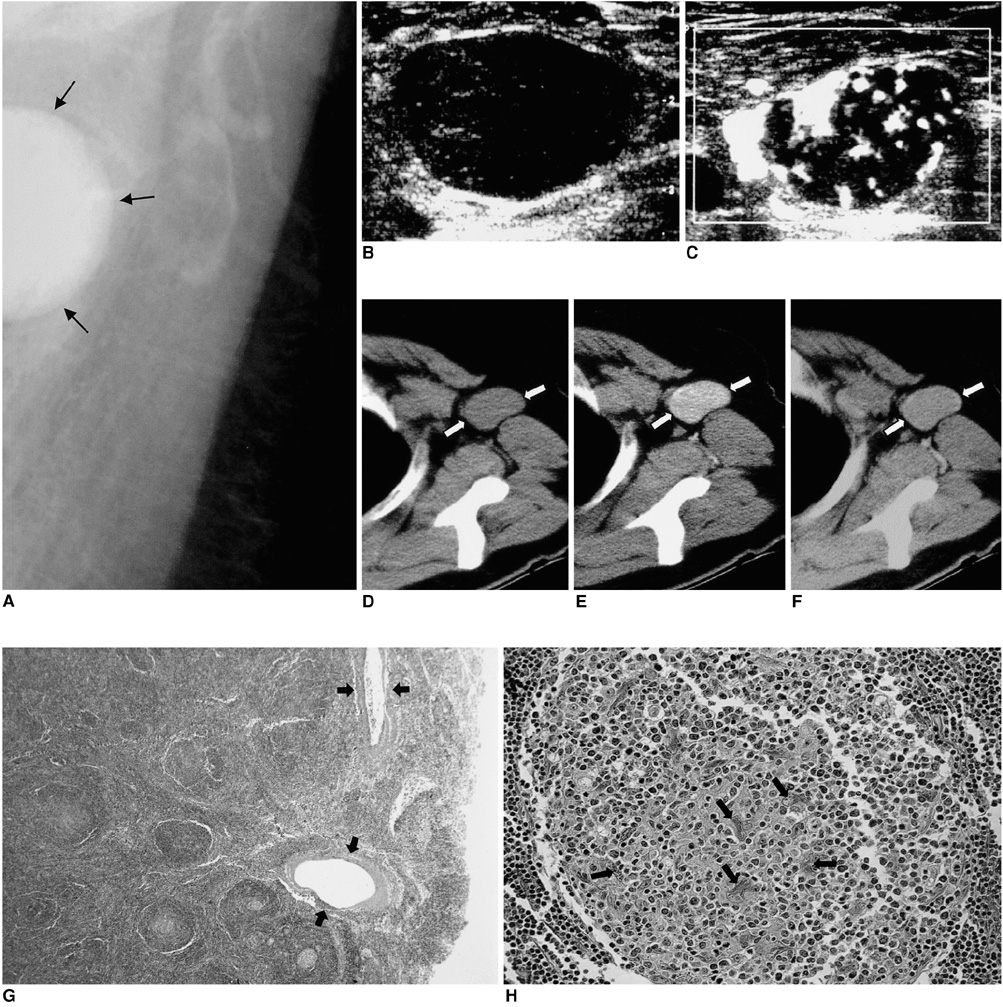Korean J Radiol.
2002 Jun;3(2):136-139. 10.3348/kjr.2002.3.2.136.
Imaging Findings of Castleman's Disease Localized in the Axilla: A Case Report
- Affiliations
-
- 1Department of Diagnostic Radiology, Korea University Hospital, Korea. ssbk@dreamwiz.com
- 2Department of Pathology, Korea University Hospital, Korea.
- 3Department of General Surgery, Korea University Hospital, Korea.
- KMID: 754074
- DOI: http://doi.org/10.3348/kjr.2002.3.2.136
Abstract
- Castleman's disease is a rare benign lymphoproliferative disorder of uncertain origin which most commonly involves the mediastinum but rarely affects the axilla. We report a case of localized Castleman's disease involving the axillary lymph node. Mammography revealed a well-defined, homogeneously dense ovoid mass, 3 cm in size, in the left axilla, while gray-scale ultrasonography (US) demonstrated a well-defined, uniformly hypoechoic ovoid mass with good through transmission. Peripheral hypervascularity was observed at power Dopper US, and early rapid homogeneous enhancement at contrast-enhanced dynamic CT.
MeSH Terms
Figure
Reference
-
1. Castleman B, Iverson L, Menendez VP. Localized mediastinal lymph-node hyperplasia resembling thymoma. Cancer. 1956. 9:822–830.2. Elizalde JM, Eizaguirre B, Lopez JI. Angiofollicular giant lymph node hyperplasia that presented with an axillary mass. Eur J Surg. 1993. 159:183–184.3. McCarthy MJ, Vukelja SJ, Banks PM, Weiss RB. Angiofollicular lymph node hyperplasia (Castleman's disease). Cancer Treat Rev. 1995. 21:291–310.4. Keller AR, Hochholzer L, Castleman B. Hyaline vascular and plasma-cell types of giant lymph node hyperplasia of the mediastinum and other locations. Cancer. 1972. 29:670–681.5. Weisenburger DD, Nathwani BN, Winberg CD, Rappaport H. Multicentric angiofollicular lymph node hyperplasia: a clinicopathologic study of 16 cases. Hum Pathol. 1985. 16:162–172.6. Danon AD, Krishnan J, Frizzera G. Morpho-immunophenotypic diversity of Castleman's disease, hyaline-vascular type: with emphasis on a stroma-rich variant and a new pathogenetic hypothesis. Virchows Arch A Pathol Anat Histopathol. 1993. 423:369–382.7. Moon WK, Kim WS, Kim IO, Yeon KM, Han MC. Castleman's disease in the child: CT and ultrasound findings. Pediatr Radiol. 1994. 24:182–184.8. Bui-Mansfield LT, Chew FS, Myers CP. Angiofollicular lymphoid hyperplasia (Castleman's disease) of the axilla. AJR. 2000. 174:1060.9. Yang WT, Chang J, Metreweli C. Patients with breast cancer: differences in color Doppler flow and gray-scale US features of benign and malignant axillary lymph nodes. Radiology. 2000. 215:568–573.10. Tschammler A, Ott G, Schang T, Seelbach-Goebel B, Schwager K, Hahn D. Lymphadenopathy: differentiation of benign from malignant disease-color Doppler US assessment of intranodal angioarchitecture. Radiology. 1998. 208:117–123.
- Full Text Links
- Actions
-
Cited
- CITED
-
- Close
- Share
- Similar articles
-
- MRI findings of castleman disease (Giant lymph node hyperplasia): case report
- Castleman's Disease in the Sigmoid Mesocolon: A Case Report
- A Case of Localized Castleman's Disease in a Patient with Rheumatoid Arthritis
- Hyaline-vascular Variant of Castleman's Disease in Retroperitoneum
- Castleman Disease Arising from IVlesentery: A Case Report


